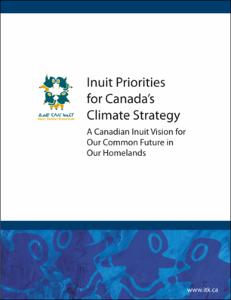| dc.coverage.spatial | Arctic Region | en_US |
| dc.coverage.spatial | Canadian Arctic | en_US |
| dc.coverage.spatial | Nunavut | en_US |
| dc.coverage.spatial | Nunavik | en_US |
| dc.coverage.spatial | Nunatsiavut | en_US |
| dc.coverage.spatial | Nunangat | en_US |
| dc.coverage.spatial | Inuvialuit Settlement Region | en_US |
| dc.date.accessioned | 2021-12-23T15:06:34Z | |
| dc.date.available | 2021-12-23T15:06:34Z | |
| dc.date.issued | 2016 | |
| dc.identifier.citation | Inuit Tapiriit Kanatami (2016) Inuit Priorities for Canada’s Climate Strategy: A Canadian Inuit Vision for
Our Common Future in Our Homelands. Ottawa, Canada, Inuit Tapiriit Kanatami, 64pp. DOI: http://dx.doi.org/10.25607/OBP-1698 | en_US |
| dc.identifier.uri | https://repository.oceanbestpractices.org/handle/11329/1831 | |
| dc.identifier.uri | http://dx.doi.org/10.25607/OBP-1698 | |
| dc.description.abstract | This report provides First Ministers and Canadian stakeholders with an overview of the diverse
and growing needs Canadian Inuit face as we adapt to climate change in Inuit Nunangat, the
Inuit homeland spanning four jurisdictions (the Inuvialuit Settlement Region in the Northwest
Territories, Nunavut, Nunavik in Québec, and Nunatsiavut in northern Labrador) that together
encompass 50 percent of Canada’s coastline and 35 percent of its landmass. It outlines our
expectations for working in partnership with the Government of Canada to avoid a one size fits
all approach to meeting the commitment Canada made in Paris, France in 2015 to transition to
a low-carbon economy.
This transition must be just and equitable for Inuit. Climate actions must be considered handin-
glove with their links to troubling socio-economic inequities faced by Inuit. Not only are
we experiencing the frontline impacts of climate change but we are also highly vulnerable to
decisions that do not take into account the unique ways in which Inuit are affected by climate
change. The social inequities Inuit face tend to be magnitudes larger than those faced by people
in most other parts of Canada. These inequities contribute to the marginalization of too many
Inuit households through limited access to education, employment, quality housing, and
adequate and nutritious food.1 Poverty in turn weighs on mental well-being, limiting the ability
of individuals to fully participate in society.
The cost-of-living is very high in our communities and the provision of heating, electricity, and
almost every other necessity is dependent on carbon-intensive activities. These factors, combined
with the reality that the majority of our households are low-income, prevent many of our families
from investing in activities such as education, quality foods, and childcare that most Canadians
take for granted.2 Too many Inuit households find the expense of buying and maintaining the
equipment needed to engage in the traditional harvesting activities that provide social, cultural,
and economic sustenance to families beyond their reach. Loss and damage due to climate
impacts can place an additional financial strain on households along with the challenge of staying
safe in increasingly unpredictable conditions.
The environment of risk that Inuit are born into is intensified by climate change. This report will
outline how targeted actions taken in full partnership with Inuit can relieve these factors,
and also describes the opportunity to address the inequities Inuit face while meeting Canada’s
commitment to transition to a low-carbon economy.
Our long term expectations for climate action include the following goals:
• Sustained resources for capacity-building and coordination that ensure Inuit are equal
partners in long-term Federal, Provincial and Territorial (FPT) climate action planning.
• Arctic climate policies that integrate Inuit knowledge and ensure the diverse climate
solutions needed in the North also lead to measureable improvements in our standard
of living until the standard of living enjoyed by Inuit is on par with that enjoyed by
Canadians as a whole. | en_US |
| dc.language.iso | en | en_US |
| dc.publisher | Inuit Tapiriit Kanatami, | en_US |
| dc.subject.other | Inuit | en_US |
| dc.subject.other | Climate change effects | en_US |
| dc.subject.other | Indigenous communites | en_US |
| dc.title | Inuit Priorities for Canada’s Climate Strategy: A Canadian Inuit Vision for Our Common Future in Our Homelands. | en_US |
| dc.type | Report | en_US |
| dc.description.status | Published | en_US |
| dc.format.pages | 64pp. | en_US |
| dc.contributor.corpauthor | Inuit Tapiriit Kanatami | en_US |
| dc.publisher.place | Ottawa, Canada | en_US |
| dc.subject.parameterDiscipline | Human activity | en_US |
| dc.description.currentstatus | Current | en_US |
| dc.description.eov | N/A | en_US |
| dc.description.adoption | National | en_US |
| dc.description.methodologyType | Guidelines & Policies | en_US |
| obps.resourceurl.publisher | https://www.itk.ca/ | |
 Repository of community practices in Ocean Research, Applications and Data/Information Management
Repository of community practices in Ocean Research, Applications and Data/Information Management
